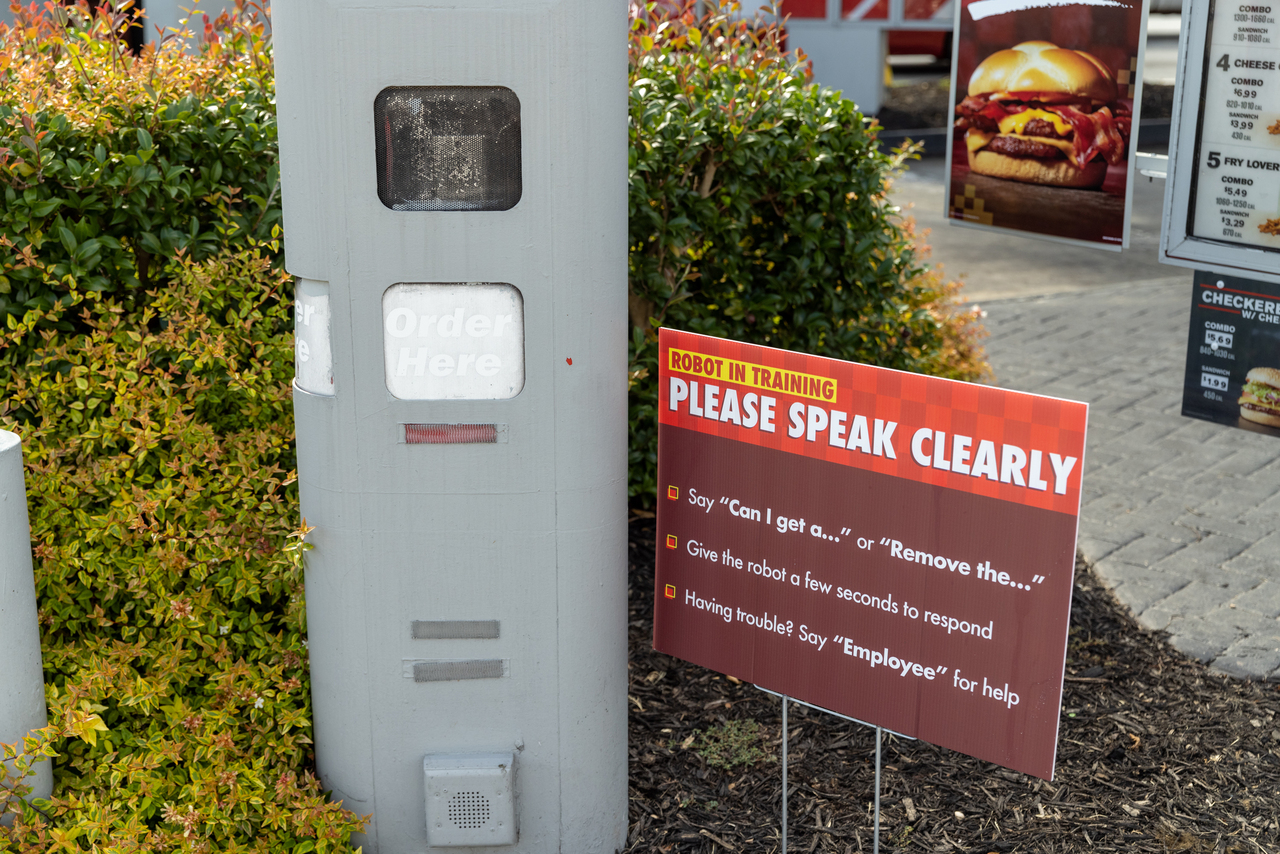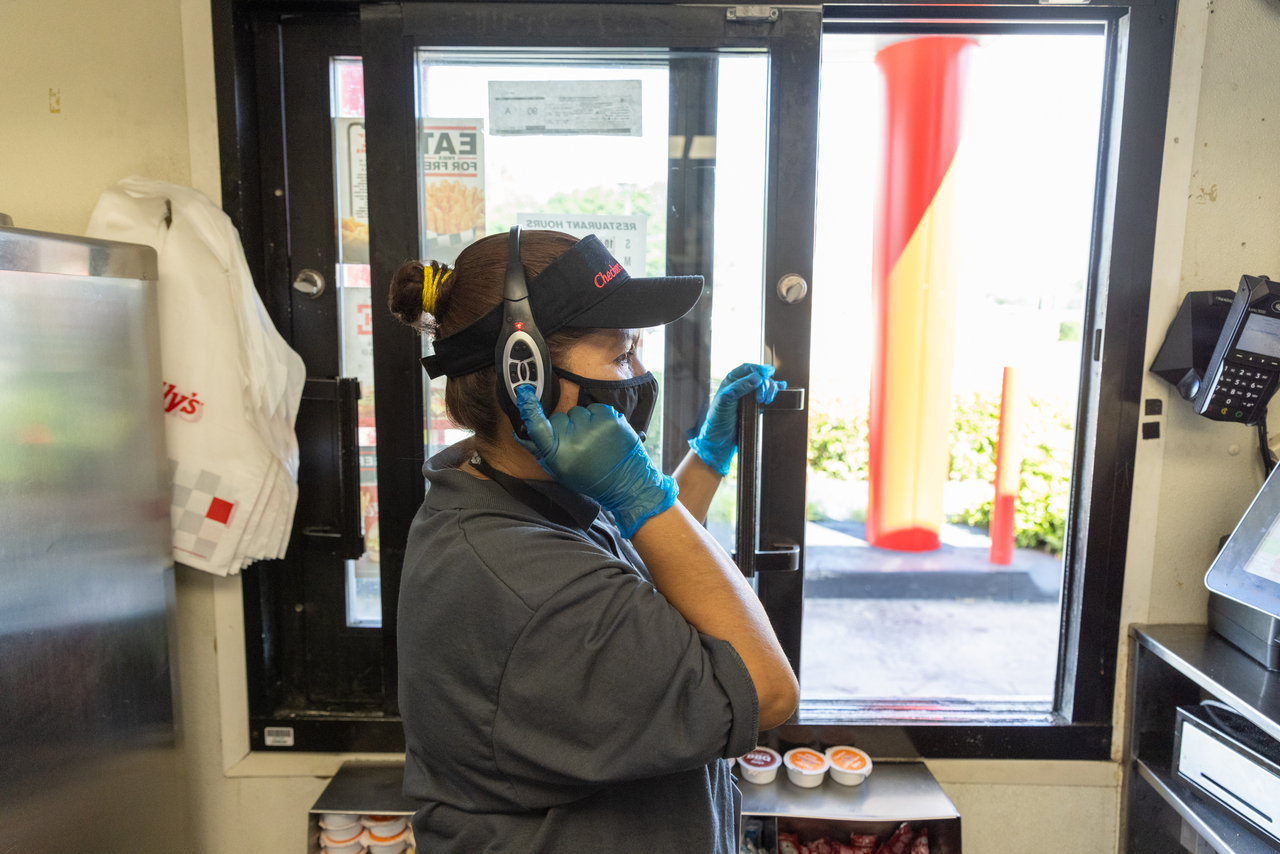Pandemic wave of automation may be bad news for workers
Sign up now: Get ST's newsletters delivered to your inbox

In the drive-thru lane at Checkers near Atlanta, requests for Big Buford burgers and Mother Cruncher chicken sandwiches may be fielded by a voice recognition algorithm.
PHOTO: NYTIMES
Follow topic:
(NYTIMES) - When Kroger customers in Cincinnati shop online these days, their groceries may be picked out not by a worker in their local supermarket but by a robot in a nearby warehouse.
Gamers at Dave & Buster's in Dallas who want pretzel dogs can order and pay from their phones - no need to flag down a waiter.
And in the drive-thru lane at Checkers near Atlanta, requests for Big Buford burgers and Mother Cruncher chicken sandwiches may be fielded not by a cashier in a headset, but by a voice recognition algorithm.
An increase in automation, especially in service industries, may prove to be an economic legacy of the pandemic. Businesses from factories to fast-food outlets to hotels turned to technology last year to keep operations running amid social distancing requirements and contagion fears. Now the outbreak is ebbing in the United States, but the difficulty in hiring workers - at least at the wages that employers are used to paying - is providing new momentum for automation.
Technological investments that were made in response to the crisis may contribute to a post-pandemic productivity boom, allowing for higher wages and faster growth. But some economists say the latest wave of automation could eliminate jobs and erode bargaining power, particularly for the lowest-paid workers, in a lasting way.
"Once a job is automated, it's pretty hard to turn back," said Casey Warman, an economist at Dalhousie University in Nova Scotia who has studied automation in the pandemic.
The trend toward automation predates the pandemic, but it has accelerated at what is proving to be a critical moment. The rapid reopening of the economy has led to a surge in demand for waiters, hotel maids, retail sales clerks and other workers in service industries that had cut their staffs. At the same time, government benefits have allowed many people to be selective in the jobs they take. Together, those forces have given low-wage workers a rare moment of leverage, leading to higher pay, more generous benefits and other perks.
Automation threatens to tip the advantage back toward employers, potentially eroding those gains. A working paper published by the International Monetary Fund this year predicted that pandemic-induced automation would increase inequality in coming years, not just in the United States but around the world.
"Six months ago, all these workers were essential," said Marc Perrone, president of the United Food and Commercial Workers, a union representing grocery workers. "Everyone was calling them heroes. Now, they're trying to figure out how to get rid of them."
Checkers, like many fast-food restaurants, experienced a jump in sales when the pandemic shut down most in-person dining. But finding workers to meet that demand proved difficult - so much so that Shana Gonzales, a Checkers franchisee in the Atlanta area, found herself back behind the cash register three decades after she started working part time at Taco Bell while in high school.
"We really felt like there has to be another solution," she said.
So Gonzales contacted Valyant AI, a Colorado-based start-up that makes voice recognition systems for restaurants. In December, after weeks of setup and testing, Valyant's technology began taking orders at one of Gonzales' drive-thru lanes. Now customers are greeted by an automated voice designed to understand their orders - including modifications and special requests - suggest add-ons like fries or a shake, and feed the information directly to the kitchen and the cashier.
The roll-out has been successful enough that Gonzales is getting ready to expand the system to her three other restaurants.
"We'll look back and say why didn't we do this sooner," she said.

A Checkers employee takes an order via a voice-recognition robot in Georgia on June 30, 2021.
PHOTO: NYTNS
The push toward automation goes far beyond the restaurant sector. Hotels, retailers, manufacturers and other businesses have all accelerated technological investments. In a survey of nearly 300 global companies by the World Economic Forum this past year, 43 per cent of businesses said they expected to reduce their workforces through new uses of technology.
Some economists see the increased investment as encouraging. For much of the past two decades, the US economy has struggled with weak productivity growth, leaving workers and stockholders to compete over their share of the income - a game that workers tended to lose.
Automation may harm specific workers, but if it makes the economy more productive, that could be good for workers as a whole, said Katy George, a senior partner at McKinsey, a consulting firm.
She cited the example of a client in manufacturing who had been pushing his company for years to embrace augmented reality technology in its factories. The pandemic finally helped him win the battle: With air travel off limits, the technology was the only way to bring in an expert to help troubleshoot issues at a remote plant.
"For the first time, we're seeing that these technologies are both increasing productivity, lowering cost, but they're also increasing flexibility," she said. "We're starting to see real momentum building, which is great news for the world, frankly."
Other economists are less sanguine. Daron Acemoglu of the Massachusetts Institute of Technology said that many of the technological investments had replaced human labour without adding much to overall productivity.
In a recent working paper, Acemoglu and a colleague concluded that "a significant portion of the rise in US wage inequality over the last four decades has been driven by automation" - and he said that trend had almost certainly accelerated in the pandemic.
"If we automated less, we would not actually have generated that much less output, but we would have had a very different trajectory for inequality," Acemoglu said.
Gonzales, the Checkers franchisee, isn't looking to cut jobs. She said she would hire 30 people if she could find them. And she has raised hourly pay to about US$10 for entry-level workers, from about US$9 before the pandemic. Technology, she said, is easing pressure on workers and speeding up service when restaurants are chronically understaffed.
"Our approach is, this is an assistant for you," she said. "This allows our employee to really focus" on customers.
Gonzales acknowledged she could fully staff her restaurants if she offered US$14 to US$15 an hour to attract workers. But doing so, she said, would force her to raise prices so much that she would lose sales - and automation allows her to take another course.
Such changes, multiplied across thousands of businesses in dozens of industries, could significantly change workers' prospects. Warman, the Canadian economist, said technologies developed for one purpose tend to spread to similar tasks, which could make it hard for workers harmed by automation to shift to another occupation or industry.
"If a whole sector of labour is hit, then where do those workers go?" Warman said. Women, and to a lesser degree people of colour, are likely to be disproportionately affected, he added.
The grocery business has long been a source of steady, often unionised jobs for people without a college degree. But technology is changing the sector. Self-checkout lanes have reduced the number of cashiers; many stores have simple robots to patrol aisles for spills and check inventory; and warehouses have become increasingly automated. Kroger in April opened a 375,000-square-foot warehouse with more than 1,000 robots that bag groceries for delivery customers. The company is even experimenting with delivering groceries by drone.
Other companies in the industry are doing the same. Jennifer Brogan, a spokesperson for Stop & Shop, a grocery chain based in New England, said that technology allowed the company to better serve customers - and that it was a competitive necessity.
"Competitors and other players in the retail space are developing technologies and partnerships to reduce their costs and offer improved service and value for customers," she said. "Stop & Shop needs to do the same."
In 2011, Patrice Thomas took a part-time job in the deli at a Stop & Shop in Norwich, Connecticut. A decade later, he manages the store's prepared foods department, earning around US$40,000 a year.
Thomas, 32, said that he wasn't concerned about being replaced by a robot anytime soon, and that he welcomed technologies making him more productive - like more powerful ovens for rotisserie chickens and blast chillers that quickly cool items that must be stored cold.
But he worries about other technologies - like automated meat slicers - that seem to enable grocers to rely on less experienced, lower-paid workers and make it harder to build a career in the industry.
"The business model we seem to be following is we're pushing toward automation and we're not investing equally in the worker," he said. "Today it's, 'We want to get these robots in here to replace you because we feel like you're overpaid and we can get this kid in there and all he has to do is push this button.'"

